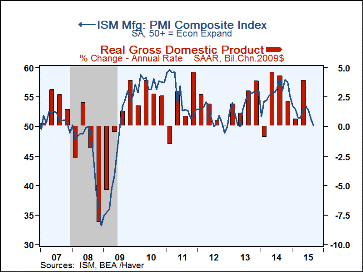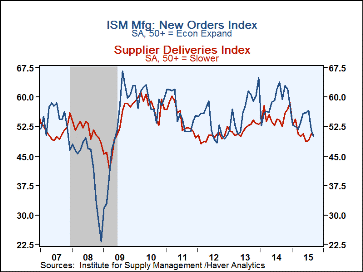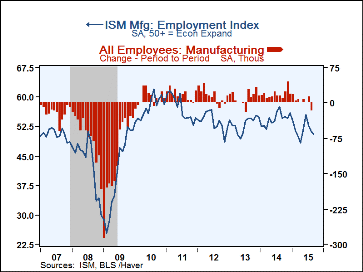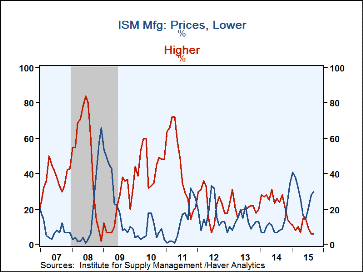 Global| Oct 01 2015
Global| Oct 01 2015U.S. ISM Factory Index Weakens to Two-Year Low; Prices Decline
by:Tom Moeller
|in:Economy in Brief
Summary
Activity in the manufacturing sector is continuing to lose steam. The Composite Index from the Institute for Supply Management (ISM) fell to 50.2 during September following an unrevised decline to 51.1 in August. It remained the [...]
Activity in the manufacturing sector is continuing to lose steam. The Composite Index from the Institute for Supply Management (ISM) fell to 50.2 during September following an unrevised decline to 51.1 in August. It remained the lowest level since May 2013. A smaller decline to 50.7 had been expected in the Action Economics Forecast Survey. During the last ten years, there has been a 73% correlation between the level of the index and the q/q change in real GDP.
Each of the component series declined m/m or was unchanged. The largest decline occurred in the production series which fell to the lowest level since May 2013. The new orders component followed, falling to the lowest point since August 2012. Each series still indicated positive growth but at sharply reduced rates. At 50.5, the employment index followed with a lesser m/m decline but it equaled a five-month low. A sharply higher 19% (NSA) of firms reduced job counts. Just 17% raised them, down from 25% three months ago. During the last ten years, there has been an 89% correlation between the index level and the m/m change in factory sector payrolls. The supplier deliveries index eased m/m, indicating slightly faster product delivery speeds. The inventories index was unchanged m/m and reflected decumulation at the quickest rate since July of last year. Twenty-three percent of companies were reducing inventories, up sharply from 15% twelve months earlier.
The prices reading declined to 39.0, the lowest level since February. Six percent of respondents indicated higher prices while 30 percent reported lower prices. During the last ten years, there has been an 85% correlation between the index and the m/m change in the core intermediate PPI.
The export order index was steady m/m, showing declines at the quickest pace since July 2012. Imports eased further to 2013 lows and the order backlog series also declined sharply.
The figures from the Institute For Supply Management (ISM) are diffusion indexes. A reading above 50 represents growth in factory sector activity. They can be found in Haver's USECON database. The expectations number is in the AS1REPNA database.
| ISM Mfg (SA) | Sep | Aug | Jul | Sep '14 | 2014 | 2013 | 2012 |
|---|---|---|---|---|---|---|---|
| Composite Index | 50.2 | 51.1 | 52.7 | 56.1 | 55.7 | 53.8 | 51.7 |
| New Orders | 50.1 | 51.7 | 56.5 | 59.4 | 59.0 | 56.9 | 52.9 |
| Production | 51.8 | 53.6 | 56.0 | 62.4 | 59.2 | 57.5 | 53.7 |
| Employment | 50.5 | 51.2 | 52.7 | 54.6 | 54.5 | 53.2 | 53.8 |
| Supplier Deliveries | 50.2 | 50.7 | 48.9 | 52.6 | 55.0 | 51.9 | 50.0 |
| Inventories | 48.5 | 48.5 | 49.5 | 51.5 | 50.8 | 49.4 | 48.2 |
| Prices Paid Index (NSA) | 38.0 | 39.0 | 44.0 | 59.5 | 55.6 | 53.8 | 53.2 |
Tom Moeller
AuthorMore in Author Profile »Prior to joining Haver Analytics in 2000, Mr. Moeller worked as the Economist at Chancellor Capital Management from 1985 to 1999. There, he developed comprehensive economic forecasts and interpreted economic data for equity and fixed income portfolio managers. Also at Chancellor, Mr. Moeller worked as an equity analyst and was responsible for researching and rating companies in the economically sensitive automobile and housing industries for investment in Chancellor’s equity portfolio. Prior to joining Chancellor, Mr. Moeller was an Economist at Citibank from 1979 to 1984. He also analyzed pricing behavior in the metals industry for the Council on Wage and Price Stability in Washington, D.C. In 1999, Mr. Moeller received the award for most accurate forecast from the Forecasters' Club of New York. From 1990 to 1992 he was President of the New York Association for Business Economists. Mr. Moeller earned an M.B.A. in Finance from Fordham University, where he graduated in 1987. He holds a Bachelor of Arts in Economics from George Washington University.










